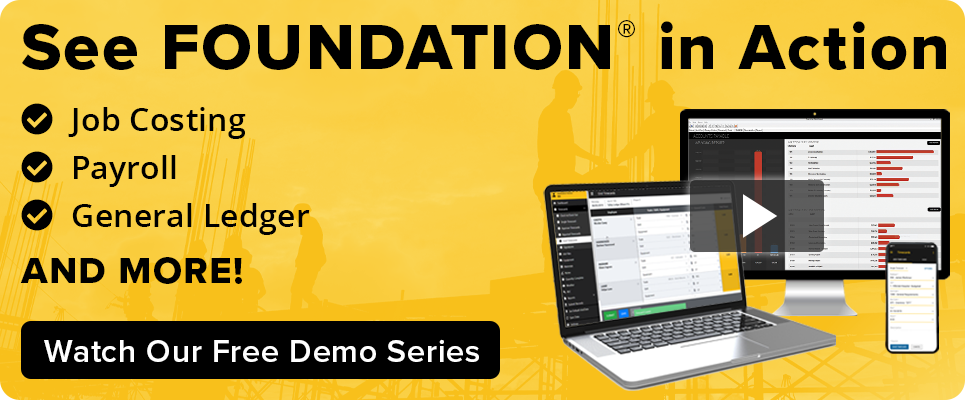
If only construction accounting and financial management could be as easy to understand as baseball.
But surprisingly, it is. America’s favorite pastime is basically a game of numbers, where keeping count and tracking statistics are the cornerstones of a team’s winning strategy. In construction, the winners are those who know their numbers and use them for better decision making. And just how do successful contractors keep score? They rely on construction accounting software. More specifically, they pack their line up with nine powerful features.
Like Little League vs. Major League, there are significant differences that separate antiquated and generic accounting software from programs designed specifically for construction. This article series will cover the features of job cost reporting.

Lead Off With Job Cost Reporting
In baseball, it is the lead-off batter’s job to get on base and get the team going. This player sets the foundation for scoring runs. In construction, job costing is what every contractor needs to simply stay in the game.
Unfortunately, not all accounting systems offer contractors the job cost reports needed to succeed. Some systems claim to provide job costing, but without the detailed tracking of job costs, they simply cannot produce the reports that contractors need. In contrast, job cost accounting systems track job costs in great detail (by job, phase, activity or cost code) so that an infinite number of job cost reports are possible.
Job Costing Takes Your Game to a New Level
No matter how job cost reporting is used, or how extensively, it is bound to have a positive impact on a construction company’s bottom line. Consider the following comparison of three excavating contractors with the same annual revenue ($20 million) and company size (seventy-five employees).
John’s Excavating, having recently upgraded to a construction-specific accounting system, is using job cost reporting at a basic level to monitor actual job costs compared to estimated costs. They track labor, material and subcontractor costs and printout a standard job cost report in order to see total costs by job. With each passing week, John can identify the jobs that are making money as well as those that are not. He no longer operates in the dark, waiting until all the bills have been submitted and money collected to discover if the job has made money.
Dan’s Excavating seeks greater details through its job cost reporting. In addition to tracking costs by job, Dan wants to see how his job costs break down by individual cost code. Using an accounting system that allows for flexible job cost coding and tracking, Dan has access to a detailed job status report. With just the click of a mouse, he can see demolition, site preparation and other cost codes broken down by labor, material and subcontract costs. This allows Dan to identify precisely which area of his job (e.g., demolition) is exceeding expectations or under-performing. Equally important, he has more detailed historical data for bidding on future jobs.
Bob’s Excavating takes an even more aggressive approach to job costing. In order to see how each crew is progressing from a production standpoint as a job unfolds, and to help forecast their costs on a daily/weekly basis, Bob relies on production reports created through his job cost accounting system. He simply enters quantities completed along with labor hours, and the software automatically calculates quantities completed per man hour (e.g., 10 square feet (SF)/hour) or how much it is costing per unit of measure (e.g., $2/SF). Why is this important to Bob? Production reporting gives him more detailed information for forecasting total job costs and calculating percent-complete. Better yet, he has access to accurate historical data, which will allow him to bid more precisely on future jobs.
The Big Bat: Job Cost Reporting
When contractors are serious about job cost reporting, the choice is clear. Good job cost accounting systems offer home runs, while off-the-shelf bookkeeping programs often strike out. Creating job cost reports from generic programs is difficult because the applications are not designed specifically for construction. They do not have the coding system or the integration with other modules to provide the detailed and flexible reporting that contractors need.
So what specific job cost reporting features should contractors look for in their accounting software? There are basically five components that lead to powerful, virtually limitless job cost reporting:
- Job Cost Detail: From simple jobs to complex, the key to efficient job costing comes down to how costs are defined and tracked. Good job cost software, therefore, must allow for flexible and customized job cost detail. Users should be able to define any number of phases, cost codes and cost classes so that they can record and report data as precisely as they need it.
- Reporting Flexibility: Good systems provide hundreds of standard reports and make it easy to customize reporting when needed with built-in report writers. Report writers/designers should be easy to use and powerful, allowing users to create their own drill-downs, equations, what-if scenarios and more.
- Ease of Integration: Among the major time-saving features of good job costing software is its ability to seamlessly integrate with third-party products such as estimating, remote timecard entry and project management applications.
- Date Sensitivity: This feature allows any report—in job costing or any other module—to be run for any time period, even months or years in the past.
- A Powerful Database: How and where data is stored also has an effect on reporting capabilities. Aside from greater data protection, Microsoft SQL, for example, allows users to take advantage of querying capabilities via Excel and other Microsoft products. That’s like having another built-in report writer!

Construction accounting and financial management may not rate as America’s favorite pastime, but it’s not a spectator sport either. Any contractor who is intent on creating a long-lasting and profitable business must understand the rules of play and commit to game-winning strategies. Leading off with good job cost software is the first and most certain way to score.
*Published in Construction Business Owner
Share Article
Keep on current news in the construction industry. Subscribe to free eNews!
Learn about our software more in depth with product overviews, demos, and much more!

Our ACA reporting & e-filing services include official 1094-C and 1095-C IRS reporting, optional e-filing (no applying for a TCC code required), mailing to your employees and experienced support to help you.

There are plenty of reasons to make FOUNDATION your choice for job cost accounting and construction management software — just ask our clients!

From job cost accounting software, to construction-specific payroll. Get an overview on your next all-in-one back-office solution.



